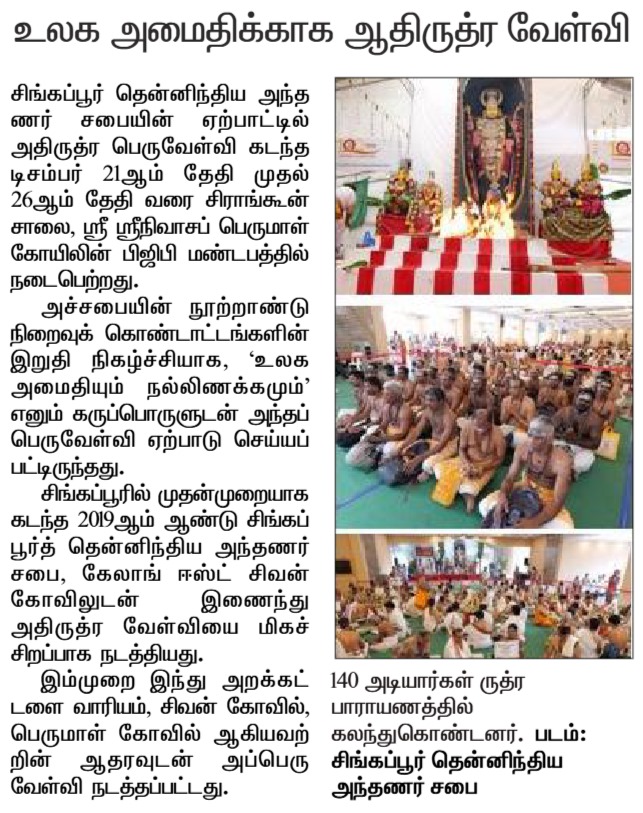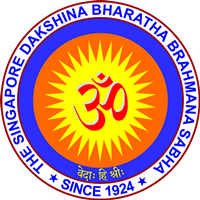Experience the Magnificence of Ati Rudra Maha Yagna 2024
The Ati Rudra Maha Yagna 2024 (21-26 December 2024 at PGP Hall, Singapore) was a spectacular offering to Lord Shiva, conducted with heartfelt prayers for Universal Welfare.
Blessed by our Gurus, guided by Vedic Pundits, supported by our patrons, energized by our dedicated volunteers and fueled by tasty prasadam, this event resonated with Vedic chants and filled devotees' hearts with divine joy.
Explore this page to relive the event through captivating video and photo highlights, along with media coverage from various outlets.
SDBBS extends its deepest gratitude to everyone who made this extraordinary event possible.
Video Highlights
Day-by-Day Video Highlights of Ati Rudram 2024
Day 1 Glimpses
Day 2 Glimpses
Day 3 Glimpses
Day 4 Glimpses
Day 5 Glimpses
Day 6 Glimpses
Day 6 - President's Speech and Feedback
Photo Highlights
Press Coverage
In Tamil Murasu, Singapore on 4 January 2025

Dinamalar, India
https://www.dinamalar.com/world-news-nri-ta/singapore/tamil-news/centenary-celebration-of-the-singapore-south-indian-anthanar-saba/17425
Namasthey Telengana:
https://www.ntnews.com/nri/singapore-dakshina-bharatha-brahmana-sabha-100th-anniversary-grandly-celebrated-1835561
AndhraPravasi:
https://www.andhrapravasi.com/news.php?news=48394&category=c2950
Namasthey NRI:
https://namastenri.net/singapore-south-indian-brahmin-sabha-100th-anniversary-atirudra-mahayagam/
Event Feedback
“This time the event was very well organized with meticulous planning and support by volunteers.
It was also nice in 2019, but the enclosed PGP hall and the 16 foot Lingothbavar brought additional energy into the space.
Thank you to Sabha and Sabha committee members for achieving this feat on the centennial year.”
- Ganapathy and Latha
“The organisation and event planning was perfect. 👏👏👏
Keep it going . Please convey my deepest gratitude & appreciation to all the MC members & spouses & all volunteers , for their untiring efforts & commitment to make this function a grand success.”
- Ashok
“Great achievement for Singapore's Brahmana in planning and conducting Ati Rudram. It has taken plenty of effort. I am very proud as a Singaporean of Brahmin origin to have been able to witness such a ceremony during my lifetime, especially in my old age. Om Namasivaya.”
- Shankar
"Sri Gurubhyo Namah, Hari Om! I feel truly blessed to have participated in the SDBBS Ati Rudram event 2024. The collective chanting and vibrations of Lord Shiva were a divine experience, and the impeccable organization made the event a resounding success. Special thanks to Sri Karthik, the MC team, the Sabha Vadyars, and all the volunteers who ensured everything went smoothly. With Lord Shiva's blessings, we can all look forward to the next Ati Rudram in Singapore!”
- Naveen
"It's really a great thought of conducting Ati Rudram, which is not a simple task to achieve. The blessings of Sri Purnambika sameta Anandeswara swamy helped gather all Singapore Brahmins in one place to fulfil the Ati Rudram dream. The event was very rare and remarkable, even compared to occurrences in India. The care in serving food for the Rutviks, the Ghanam organization, and the hospitality for the Rutviks from India were truly commendable and made everyone feel very happy."
- Nemani Satya Ramesh
"My heartfelt appreciation to Shri. Karthik ji, Suresh ji, the Sabha committee, Vadhyars, and volunteers for orchestrating a flawless Athirudra Maha Yagna. The serene six days of Sri Rudra Chamakam mantra chanting, enriched by meaningful interactions with fellow devotees, was a lifetime blessing. Although I could not participate as a Ritwik due to my knee injury, I embraced my role as a general chanter with gratitude, bowing to the spirit of Bhagawat Sangkalpam. With Ishwara kripa guiding every step, may Lord Shiva continue to bless our Sabha and inspire us with health, joy, and spiritual enlightenment into 2025 and beyond."
- T. N. Soma Somasundaram“I want to express my deepest appreciation to you for the fabulous gifts and prasadams that you had given, on behalf of the Brahmana Sabha. It is not only just motivating but very inspiring and generous. Thank you so much. I will also be going through the YouTube videos that you had sent to mark the Ati Rudram celebrations.”
- Sukumar"Heartfelt thanks for an unforgettable Ati Rudram. Your meticulous planning and dedicated execution crafted an atmosphere of divine connection and peace, leaving an indelible mark on all of us. May Lord Shiva bless the SDBBS MC and every volunteer with abundant grace for making this sacred experience possible.”
- Ramanath HS“Great event. Thanks to everyone who contributed. Special shout out to Rajaram. And kudos to your leadership and MC team.”
- Hari Gurunath"I salute your inspiring leadership and the fantastic team behind this extraordinary AtiRudra event. It was a mesmerizing symphony of dedication and excellence that truly set a high standard. We are deeply blessed to have a Brahmana Sabha that upholds the sacred ideals of the Vedas. May Poornambika Anandeshwar shower their choicest blessings upon you all."
- Ram“Om Namah Shivaya, we were truly blessed to attend the Athirudram event at Simhapuri (Singapore) as part of the Sabha's Shathamana Utsavam celebrations. The experience was profoundly blissful, and the positive energy will inspire us for our upcoming Platinum Jubilee celebration in February 2026. Exceptional coordination by the Pandits, chanting team, and organizing team made this event a remarkable milestone. Heartfelt thanks to Shri Ramakrishna NS (Ramesh) and his family for their meticulous arrangements. We invite everyone to join us for the Athirudram in Bangalore from 9th February 2026 to 19th February 2026. Jai Sriram”
- Ramanathan V S
